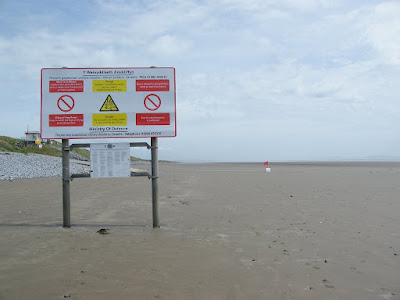Ages: Colin was 79 years and 127 days. Rosemary was 76 years and
269 days.
Weather: Very wet.
Location: Amroth to Pendine.
Tide: Out.
Rivers: None.
Ferries:
None.
Piers:
None.
Pubs:
None.
‘Cadw’
properties: None.
Ferris
wheels: None.
How we got there and back: We were staying in our caravan at
Freshwater East. After visiting Laugharne we paid a quick visit to
Pendine, but didn't stay because it was pouring with rain.
(We visited Laugharne and Pendine in the wrong order in our
efforts to avoid roadworks traffic lights, but in actual fact we got
rather lost!)
The following May we visited Pendine again because we felt we hadn't
done it justice. The weather was much better and we walked on the
famous sands for a bit.
We drove into Pendine in the teeming rain at the end of a very long
day. We parked momentarily while I nipped out of the car and took
just one quick photo of the famous sands. Then we returned to the
caravan.
We really felt we hadn't done Pendine justice. So eight months
later, when we were in the area again, we returned. The weather was
much better that day. Colin wanted to visit the Museum of Speed, but
we found that it was being rebuilt and it was only half finished. So
he was disappointed.
The Coast Path leaves Pembrokeshire where it leaves Amroth, and
enters the county of Carmarthenshire. The four miles between Amroth
and Pendine show very close contours on the map — up and down, up
and down. I couldn't possibly have walked it in any weather in my
present state of mobility, I realise that now. We looked at the
cliffs from the sands, in particular at the steepness of the path
coming down into Pendine. Despite my fantastic replacement knees, I
can't do steep slopes downwards like that anymore.
In the early 1900s the sands were used as a venue for car and motor
cycle races. From 1922 the annual Welsh TT motor cycle event was
held at Pendine Sands. The firm, flat surface of the beach created a
race track that was straighter and smoother than many major roads of
the time.
The first person to use Pendine Sands for a world land speed record
attempt was Malcolm Campbell. On 25 September 1924 he set a world
land speed record of 146.16 mph on Pendine Sands in his Sunbeam 350HP
car Blue Bird. Four other record-breaking runs were made on Pendine Sands between 1924 and 1927; two more by Campbell, and two by Welshman J. G. Parry-Thomas in his car Babs.
Campbell raised the record to 174.22 mph in February 1927 with his
second Blue Bird. On 3 March 1927 Parry-Thomas attempted to beat
Campbell's record. On his final run while travelling at about 170
mph the car crashed. There is an untrue urban myth that the exposed
drive chain broke and partially decapitated him; Babs went out
of control and rolled over Parry.
The Ministry of Defence acquired Pendine Sands during the Second
World War and used it as a firing range. The beach is still owned by
the Ministry of Defence; prominent signs warn of the dangers of
unexploded munitions and public access is restricted.







No comments:
Post a Comment